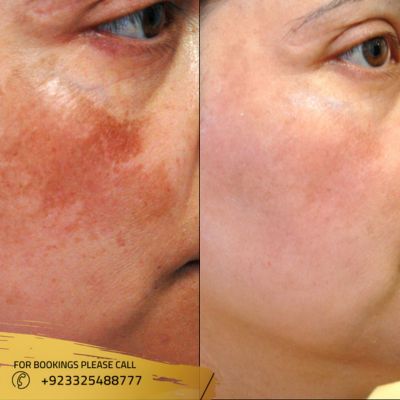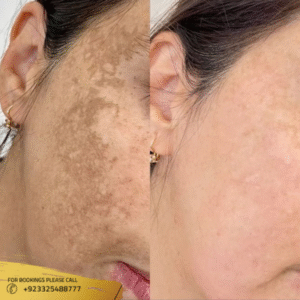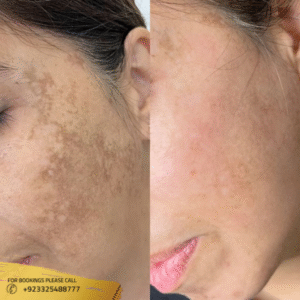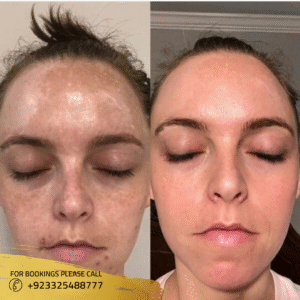
Melanin serves as your skin’s natural protection against harmful UV rays. However, various factors can disrupt its production, causing it to accumulate in certain areas (hyperpigmentation) or decrease in others (hypopigmentation). Understanding the type and cause of your pigmentation is essential for effective treatment. So we have compiled this guide for you to get the best skin pigmentation treatment in Islamabad.
Types of skin pigmentation:
Hyperpigmentation:
Hyperpigmentation is the most common type of pigmentation, and it occurs when certain areas of your skin produce excess melanin, resulting in dark patches or spots. Common forms of micropigmentation are as follows:
Melasma: Melasma appears as brown or grayish patches, typically on the face, particularly the cheeks, forehead, nose, and upper lip. This condition predominantly affects women and is often triggered by hormonal changes during pregnancy, birth control use, or hormone therapy.
Post-Inflammatory Hyperpigmentation (PIH): PIH develops after skin inflammation or injury, such as acne, burns, cuts, or aggressive cosmetic procedures. This type is particularly common in individuals with darker skin tones.
Sun Spots (Solar Lentigines) Also called age spots or liver spots, these flat, brown spots appear on sun-exposed areas like the face, hands, shoulders, and arms. They develop after years of cumulative sun exposure and become more common with age
Hypopigmentation:
Hypopigmentation occurs when skin produces less melanin than normal, resulting in light patches or spots. Common forms of hypopigmentation are as follows:
Vitiligo: Vitiligo is an autoimmune condition that causes patches of skin to lose pigment completely, appearing white or very light.
Post-Inflammatory Hypopigmentation: Similar to PIH but opposite in effect, this occurs when inflammation or injury causes decreased melanin production, leaving lighter patches.
Causes of Skin Pigmentation
Understanding what triggers pigmentation helps in prevention and treatment:
Sun Exposure:
Ultraviolet (UV) radiation is the primary cause of pigmentation issues. Sun exposure triggers melanin production as a protective response. Repeated or excessive exposure leads to uneven melanin distribution, causing sun spots, freckles, and worsening of existing pigmentation.
Hormonal Changes:
Hormonal fluctuations significantly impact melanin production. Common triggers include: Pregnancy (causing melasma or “pregnancy mask”), Birth control pills, Hormone replacement therapy, Thyroid disorders, and Menopause.
Aging:
Natural aging processes affect pigmentation:
- Decreased melanocyte function.
- Accumulated sun damage becomes visible.
- Slower skin cell turnover.
- Age spots development.
Different Treatments for Skin Pigmentation at RCS:
Royal Cosmetic Surgery Islamabad offers comprehensive skin pigmentation treatments in Islamabad:
Chemical Peels Professional chemical peels at various strengths remove pigmented skin layers, revealing fresh, even-toned skin underneath. Types include:
- Superficial peels (glycolic, lactic acid).
- Medium peels (TCA).
- Deep peels (phenol – for severe cases).
Laser Treatments Advanced laser technology targets and breaks down melanin deposits:
Q-Switched Lasers: Effective for stubborn pigmentation, sun spots, and tattoo removal. Minimal downtime.
Fractional Lasers: Treat both pigmentation and texture issues simultaneously. Stimulate collagen production.
IPL (Intense Pulsed Light): Broad-spectrum light targets multiple pigmentation types in one treatment. Gentle with minimal downtime.
Laser treatments typically require 3-6 sessions for optimal results.
Microdermabrasion Gentle exfoliation that removes dead skin cells and superficial pigmentation. Best for mild pigmentation. Multiple sessions needed. No downtime.
Microneedling with Serums Tiny needles create controlled micro-injuries, triggering collagen production and allowing deep penetration of brightening serums. Effective for PIH and overall tone improvement.
Cryotherapy Freezing treatment using liquid nitrogen to remove sun spots and certain pigmented lesions. Quick procedure with minimal discomfort.
Dermal Infusion Combines exfoliation, extraction, and serum infusion to treat superficial pigmentation while deeply hydrating skin.
Combination Therapy:
The most effective approach often combines multiple treatments:
- Topical agents + professional procedures.
- Different lasers targeting various pigmentation depths.
- Chemical peels + lightening creams.
- Microneedling + vitamin C serums.
Oral Medications:
For certain conditions, oral treatments may include:
- Tranexamic acid for melasma.
- Antioxidant supplements.
- Medications for underlying conditions.
- Vitamin supplements.
Skin micropigmentation results:
We take pictures of before and after skin pigmentation results of our patients, because we do not only stop at treatment, but we also walk you through your recovery process until the complete results of the procedure become visible. In case of skin pigmentation, there are certain factors that affect the results:
- Type and depth of pigmentation.
- Skin type and tone.
- Treatment consistency.
- Sun protection compliance.
- Overall health and lifestyle.
- Realistic expectations.
- Multiple treatment sessions are usually necessary.
- Results vary among individuals.
Cost of SkinPigmentation Treatment in Islamabad
At Royal Cosmetic Surgery Islamabad, we offer comprehensive pigmentation treatment The cost of skin pigmentation treatment in Islamabad ranges from 15,000 PKR to 25,000 PKR:
| Procedure | Cost |
| Cost of chemical peel in Islamabad | starts at PKR 20,000 |
| Cost of Q-switched Laser in Islamabad | starts at PKR 25,000 |
| Cost of Fractional Laser in Islamabad | starts at PKR 12,000 |
| Cost of microdermabrasion in Islamabad | starts at PKR 25,000 |
| Cost of microneedling in Islamabad | starts at PKR 15,000 |
Cost Factors:
- Type and severity of pigmentation.
- Treatment method selected.
- Number of sessions required.
- Areas being treated.
- Products and technology used.
Why choose Royal Cosmetic Surgery Islamabad for skin pigmentation treatment?
If you want to address the skin pigmentation, it is very important to choose the right clinic, as all the facilities and equipment will be provided by them:
- Expert Dermatologists: Dr Ayusha khan is a highly trained specialist with years of experience treating all pigmentation.
- Advanced Technology: latest laser systems, chemical peels, and treatment equipment.
- Customized Protocols: Personalized treatment plans based on your skin type, pigmentation, and goals.
- Safety First: Highest standards of sterility and patient safety.
- Proven Results: 12,000 satisfied patients trust our expertise.
- Quality Products: Pharmaceutical-grade topical treatments.
Book Your Consultation Today!
Take the first step toward clear, even-toned skin. Our pigmentation specialists will assess your concerns and create a personalized treatment plan.









